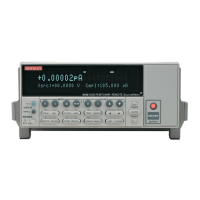F-6 Measurement Considerations
Source capacitance
DUT source capacitance will also affect the noise performance of the ammeter. In general,
as source capacitance increases, the noise gain also increases.
The elements of interest for this discussion are the capacitance (C
DUT
) of the DUT and the
internal feedback capacitance (C
F
) for the ammeter. Taking into account the capacitive reac-
tance of these two elements, our previous noise gain formula must be modified as follows:
Output V
NOISE
= Input V
NOISE
(1 + Z
F
/Z
DUT
)
where;
• Output V
NOISE
is the noise seen at the output of the ammeter.
• Input V
NOISE
is the noise seen at the input of the ammeter.
• Z
F
is the internal feedback impedance for the ammeter that is formed by C
F
and R
F
.
• Z
DUT
is the internal impedance of the DUT that is formed by C
DUT
and R
DUT
.
Furthermore,
and
Note that as C
S
increases in value, Z
DUT
decreases in value, thereby increasing the noise
gain. Again, at the point where Z
DUT
= Z
F
, the input noise is amplified by a factor of two.
The maximum values of DUT capacitance (C
DUT
) for the ammeter are listed in Table 3-3
(see Basic source-measure procedure, current measurements and capacitive loads in Section 3.
You can, however, usually measure at higher load capacitance values by inserting a resistor in
series with the ammeter input. Remember that any series resistance will increase the voltage
burden by a factor of I
IN
x R
SERIES
. For example, the range of resistance listed in Table F-1
will result in voltage burden values in range of l mV to 1V. A useful alternative to a series resis-
tor is a series diode, or two diodes in parallel back-to-back. The diodes can be small-signal
types and should be in a light-tight enclosure.
Generated currents
Any extraneous generated currents in the test system will add to the desired current, causing
errors. Currents can be internally generated, as in the case of instrument input offset current, or
they can come from external sources such as insulators and cables.
Offset currents
Internal offset current — The ideal ammeter should read zero when its input terminals are
left open. Practical ammeters, however, do have some small current that flows when the input is
Z
F
R
F
2πfR
F
C
F
( )
2
1+
--------------------------------------------=
Z
DUT
R
S
2πfR
S
C
S
( )
2
1+
--------------------------------------------=

